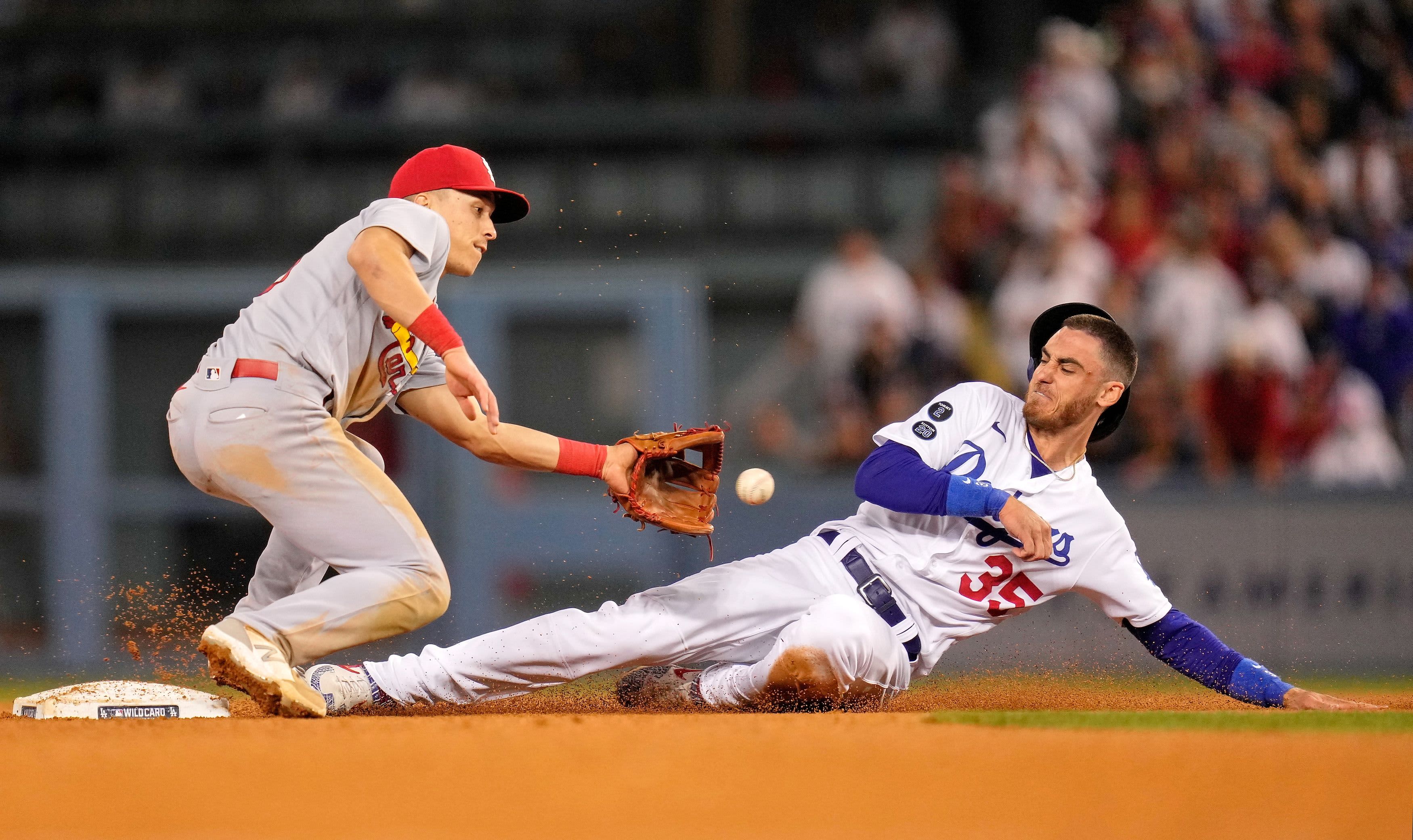
Los Angeles Dodgers center fielder Cody Bellinger (35) steals second base as St. Louis Cardinals second baseman Tommy Edman (19) takes the late throw during the seventh inning at Dodger Stadium.
Robert Hanashiro | USA TODAY Sports
Major League Baseball’s collective bargaining agreement officially expired midnight Thursday, and team owners voted to lock out players after failing to reach a new deal.
Shortly after midnight, the MLB Players Association called the shutdown a “dramatic measure.”
“It was the owners’ choice, plain and simple, specifically calculated to pressure players into relinquishing rights and benefits, and abandoning good faith bargaining proposals that will benefit not just Players, but the game and industry as a whole,” the MLBPA said in a statement.
The MLBPA said, however, it remains determined to hash out a negotiated CBA that is “fair to all parties, and provides fans with the best version of the game we all love.”
Commissioner Rob Manfred defended the lockout as “necessary,” saying the MLBPA’s vision for the league “would threaten the ability of most teams to be competitive.”
League deputy commissioner Dan Halem and MLBPA negotiator Bruce Meyer met on Wednesday in Dallas. Still, talks ended with the sides remaining apart on issues.
The labor stoppage is the ninth in MLB history and the first since a player strike in 1994. That labor dispute lasted 232 days, and MLB owners also canceled the 1994 World Series due to the strike.
In his letter, Manfred said, “we cannot allow an expired agreement to again cause an in-season strike and a missed World Series, like we experienced in 1994. We all owe you, our fans, better than that.”
But with another lockout in place, a $10 billion industry is now frozen.
Player transactions are halted, and clubs are now restricted from contacting players in the offseason until the lockout is lifted. In addition, MLB’s Winter Meetings, scheduled for Dec. 6-9 in Orlando, will be canceled.
The work stoppage comes during a free-agent frenzy that saw over $2 billion in deals negotiated. The deals include the Texas Rangers’ $325 million contract to land shortstop Corey Seager, and the New York Mets gave pitcher Max Scherzer a three-year, $130 million deal.
Still, players believe the current CBA doesn’t favor them; hence, they’re seeking changes.
The MLBPA wants to address service time rules that restrict most young players to teams for the first six years of their career. The union also wants a luxury tax overhaul to lure teams to spend more on player salaries without fear of harsh tax penalties.
Major League Baseball Commissioner Robert D. Manfred Jr. and Major League Baseball Players Association Executive Director Tony Clark speak during a press conference before Game 3 of the Championship Round of the 2017 World Baseball Classic between Team USA and Team Puerto Rico on Wednesday, March 22, 2017 at Dodger Stadium in Los Angeles, California.
Alex Trautwig | Major League Baseball | Getty Images
In the current CBA, teams that exceed the MLB’s payroll threshold are taxed between 20% and 95% depending on repeater status.
The union wants to change the MLB’s free agency structure to get younger stars paid sooner and seek more money, including a bump in minimum salaries, which stand at $570,500.
Player salaries declined for a third straight year, according to the Associated Press. The outlet estimated the average player salary in the MLB was $3.7 million for the 2021 season. That’s down from a record-high $4.1 million in 2017.
More postseason inventory
Meanwhile, MLB proposals include a $100 million salary floor to combat teams not spending enough on players. Team owners also offered a $1 billion pool to replace salary arbitration.
The thing is, those items aren’t likely to be accepted. What owners genuinely desire is more postseason games and to raise the number of clubs contending for a World Series from 10 teams to 14.
Freddie Freeman #5 of the Atlanta Braves celebrates with Joc Pederson #22 after hitting a solo home run against the Houston Astros during the seventh inning in Game Six of the World Series at Minute Maid Park on November 02, 2021 in Houston, Texas.
Carmen Mandato | Getty Images
That would help increase media rights money, as the bulk of MLB’s national TV revenue comes from postseason games.
Fox will start paying its $5.1 billion contract to MLB in 2022, and WarnerMedia agreed to an over $3 billion package to keep its MLB rights.
But should MLB land more postseason inventory, ESPN will have exclusive rights to all Wild Card games as part of a $4 billion package.
February the actual deadline?
With many issues to negotiate, few in MLB circles expect a quick resolution in this lockout.
“I think they [MLBPA] are committed to gaining ground,” said former MLB executive Marty Conway. “Inside the baseball level, it’s about the system of determining free agency, which the owners and baseball operators completely control.
“It’s going to be weeks before we see any reasonable progress,” he added.
Conway, now a sports management professor at Georgetown University, suggested February 2022 would be a more realistic deadline as clubs and players prepare for spring training.
“There’s plenty of money to go around,” said Conway. “This negotiation will be more about how it’s shared and the future of people who participate in that revenue pie.”
In his letter, Manfred said the lockout won’t necessarily lead to game cancellations, arguing the league took “this step now because it accelerates the urgency for an agreement with as much runway as possible to avoid doing damage to the 2022 season.”




